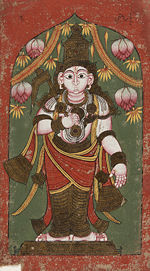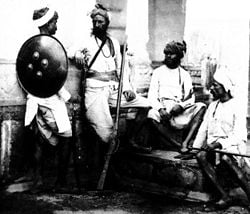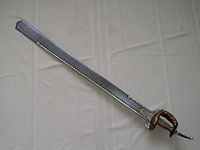Indian Martial Arts
The Indian subcontinent is home to a variety of martial arts. Dhanurveda (from dhanus "bow" and veda "knowledge") is the term for the "science of archery" in Puranic literature, later applied to martial arts in general.
Martial arts of the Indian subcontinent are diverse in nature and have origins of different times from various different regions. Some of the older traditions include the organised martial systems practiced by the Kshatriya warrior caste of Hinduism. These systems include armed and unarmed combat, and aspects such as meditation and mental conditioning. Many ancient Hindu temples have statues of deities and warriors in various postures related to combat. A number of ancient Dravidian martial arts were developed in South India, including Kuttu Varisai (empty hand combat) and Varma Kalai (the art of vital points) in Tamil Nadu, and Kalarippayattu (way of the arena) and Adithada (attack and defend) in Kerala.[1]
The theories behind Yoga, Ayurveda and Tantra, such as Kundalini (coiled energy), Prana (life force), Nadi (meridians), Chakra (aura) and Marmam (pressure points), are also present in Indian martial arts.[citation needed]
History
Antiquity (pre-Gupta)
The Indian epics contain accounts of combat, describing warriors such as Bhima. The Mahabharata describes a prolonged battle between Arjuna and Karna using bows, swords, trees and rocks, and fists.[2] Another unarmed battle in the Mahabharata describes two fighters boxing with clenched fists and fighting with kicks, finger strikes, knee strikes and headbutts.[3] Other boxing fights are also described in Mahabharata and Ramayana.[4]
Stories describing Krishna report that he sometimes engaged in wrestling matches where he used knee strikes to the chest, punches to the head, hair pulling, and strangleholds.[5] Based on such accounts, Svinth (2002) traces press ups and squats used by Indian wrestlers to the pre-classical era.[5]
Many authorities contend that the 4th century B.C.E. conquest of India by Alexander the Great laid the foundation of Indian martial arts by dispersing pankration techniques throughout the subcontinent.[6][7] Notable figures, such as Tatsuo Suzuki, Hirokazu Kanazawa, and Masutasu Oyama have pointed out the influence of Pankration on Indian martial arts.[8]
Around the 3rd century B.C.E., Patanjali wrote the Yoga Sutras, which taught how to meditate single-mindedly on points located inside one's body, which was used in later martial arts, while various mudra finger movements were taught in Yogacara Buddhism. These Yoga elements, as well as finger movements in the nata dances, were later incorporated into various martial arts.[5]
The word "kalari" is mentioned in Sangam literature from the 2nd century B.C.E. The Akananuru and Purananuru describe the martial arts of ancient Tamilakkam, including forms of one-to-one combat, and the use of spears, swords, shields, bows and silambam. The word "kalari" appears in the Puram [9] and Akam [10] to describe to both a battlefield and combat arena.
The references to "Silappadikkaram" in Sangam literature dating back to the 2nd century refer to the sale of Silamabam staves, swords, pearls and armor to foreign traders. The silambam staff was one of the martial art weapons, which was in great demand with the visitors.[11][12]
References to martial arts are found in early Buddhist texts. The Lotus Sutra (ca. 1st century AD) refers to a boxing art while speaking to Manjusri.[13] The Lotus Sutra also categorized combat techniques as joint locks, fist strikes, grapples, and throws,[14] and also referred to a martial art with dance-like movements called Nara.[15] Another early Buddhist sutra Hongyo-kyo describes a "strength contest" between Gautama Buddha's half-brother Prince Nanda and his cousin Devadatta.[13] Other stories suggest that Siddhartha Gautama was a champion of martial arts and archery before becoming the Buddha.[5]
The Vishnu Purana text describes Dhanur Veda as one of the traditional eighteen branches of knowledge.[2]
Classical period (3rd to 9th centuries)
Like other branches of Sanskrit literature, treatises on martial arts become more systematic in the course of the 1st millennium AD.
The martial art of Vajra Mushti is also mentioned in sources of the early centuries CE.[13] Indian military accounts of the Gupta Empire (c. 240-480) identified over 130 different classes of weapons. The Kama Sutra written by Vātsyāyana at the time suggested that women should regularly "practice with sword, single-stick, quarter-staff, and bow and arrow." Around this time, Tantric philosophers developed important metaphysical concepts such as kundalini energy, chakras, and mantras.[5]
The Sushruta Samhita (c. 4th century) identifies 107 vital points of the human body in his Sushruta Samhita.[16] Of these 107 points, 64 were classified as being lethal if properly struck with a fist or stick.[5] Sushruta's work formed the basis of the medical discipline Ayurveda, which was taught alongside various Indian martial arts that had an emphasis on vital points, such as Varma Kalai and Marma Adi.[5] With numerous other scattered references to vital points in Vedic and epic sources, it is certain that India's early martial practitioners knew and practiced attacking or defending vital points.[17]
Martial arts were not exclusive to the Kshatriya warrior caste, though they used the arts more extensively. The 8th century text Kuvalaymala by Udyotanasuri recorded martial arts being taught at salad and ghatika educational institutions, where Brahmin students from throughout the subcontinent (particularly from South India, Rajasthan and Bengal) "were learning and practicing archery, fighting with sword and shield, with daggers, sticks, lances, and with fists, and in duels (niuddham)."[2]
Around 630, King Narasimhavarman of the Pallava dynasty commissioned dozens of granite sculptures showing unarmed fighters disarming armed opponents. These may have shown an early form of Varma Adi, a Dravidian martial art that allowed kicking, kneeing, elbowing, and punching to the head and chest, but prohibited blows below the waist. This is similar to the Dhanur Veda martial art described in the Agni Purana.[5]
The earliest extant manual of Dhanur Veda is in the Agni Purana (c. 8th century),[17] which contains several chapters giving descriptions and instructions on the fighting arts of Dhanur Veda, with reference earlier sutras on Dhanur Veda dating back centuries earlier.[18] It described how to improve a warrior's individual prowess and kill enemies using various different methods in warfare, whether a warrior went to war in chariots, elephants, horses, or on foot. Foot methods were subdivided into armed combat and unarmed combat.[5] The former included the bow and arrow, the sword, spear, noose, armour, iron dart, club, battle axe, discus, and the trident.[2] The latter included wrestling, knee strikes, and punching and kicking methods.[5]
Middle Ages (10th to 15th centuries)
Organised martial arts in ancient India include the martial art of Malla-yuddha, a form of combat wrestling codified into four forms,[19] The Malla Purana (ca. 13th century) is the earliest treatise discussing the techniques of Malla-yuddha.
The modern forms of Marma Adi, Varma Ati,[5] and Kalarippayattu were developed by the 11th century, during an extended period of warfare between the Chera and Chola dynasties.[20]
Modern period (1857 to present)
Kalarippayattu underwent a period of decline after the introduction of firearms and especially after the full establishment of British colonial rule in the 19th century.[17] More European modes of organizing police, armies and governmental institutions, and the increasing use of firearms, gradually eroded the need for traditional martial training associated with caste-specific duties.[20] The British colonial government banned kalarippayattu in 1804 in response to a series of revolts.[21][verification needed]
The resurgence of public interest in kalarippayattu began in the 1920s in Tellicherry as part of a wave of rediscovery of the traditional arts throughout South India which characterized the growing reaction against British colonial rule.[20]
During the period, Indian wrestling became prominent in western catch wrestling tournaments. [22][23][24][25][26]
Indian weapons
According to P C Chakravati in The Art of War in Ancient India, Indian armies used standard weapons such as wooden or metal tipped spears, swords, thatched bomboo shields, wooden shields, metal shields, axes, short bows and long bows in warfare as early as the invasion of India by the forces of Alexander of Macedon, and these weapons are all mentioned in even earlier native texts. Some troops in ancient times wore personal armor, but the majority did not until medieval times. Armed forces were largely standardised, and it is unclear if regular infantry were trained in any recognisable Indian martial art, other than standard military drills. Over time, weapondary evolved, and India became famed for its flexible wootz steel. Invasion in the 13th century from the pourous northwestern mountain passes that lead from Cerntal Asia and the Middle East into India, likely inspired new forms of weapondary, such as the talwar, a curved blade resembling Persian and Turkic arms. Curved blades had been used in India since ancient times, some even curved toward the cutting side like a sickle, but before the introduction of the talwar, the stright khanda type sword may have enjoyed greater popularity. Martial artists, typically coming from warrior jatis, employed other uniquely weapons such as the katar sword-gauntlet and urumi sword-whip.
Influence of Indian martial arts
The martial arts of India have influenced the martial arts of other countries, particularly within the Indosphere, those regions outside India influenced by Indian culture. Examples of such arts include Bando,[27] Silat,[28][29] Escrima,[30] and Muay Thai.[31][32]
The Tamil kingdoms were instrumental in the spread of Silambam throughout Southeast Asia. During the 18th and the 19th centuries Silambam was much more prevalent in Southeast Asia than in India, where it was banned by the British government.[33]
India has also influenced the Portuguese martial art of Jogo do Pau.[34][35]
The practice of Indian clubs swinging was first introduced to England by British soldiers who had studied the discipline while stationed in India during the 1800s. The Indian clubs were used by military cadets and appeared as a gymnastic event in the 1904 Olympics. Gymnasiums were built just to cater to club exercise groups. [36][37][38][39][40][41]
Russian officials travelled to India, under the employ of NKVD physical training center, "Dinamo", to observe its native martial arts. The collection of techniques from martial arts of various countries — including India — formed the basis of the Russian martial art Sambo. V.A. Spiridinov was assigned to Mongolia, China and India to research the Mongol-Vedic martial arts.[42]
The Indian wrestling form of Pehlwani has influenced both catch wrestling and it's derivative system of shoot wrestling. Karl Istaz applied the training methods of Indian wrestlers to shoot wrestling; this philosophy was later passed on to several of his students.[43][44][45]
Doshin So, the founder of Shorinji Kempo, was convinced that a Shaolin temple wall painting depicted Chinese and Indian monks practicing martial arts together for spiritual edification.[46][47]
In addition, modern martial arts such as Brazilian Jiu Jitsu credit India as a founding influence on their fighting principles.[48][49][50][51][52][53]
Notes
- ↑ Luijendijk, D.H. (2005) Kalarippayat: India's Ancient Martial Art, Paladin Press, ISBN 1-58160-480-7
- ↑ 2.0 2.1 2.2 2.3 Zarrilli, Phillip B. A South Indian Martial Art and the Yoga and Ayurvedic Paradigms. University of Wisconsin-Madison.
- ↑ Section XIII: Samayapalana Parva, Book 4: Virata Parva, Mahabharata.
- ↑ Shamya Dasgupta (June-September 2004). "An Inheritance from the British: The Indian Boxing Story", Routledge 21 (3), p. 433-451.
- ↑ 5.00 5.01 5.02 5.03 5.04 5.05 5.06 5.07 5.08 5.09 5.10 J. R. Svinth (2002). A Chronological History of the Martial Arts and Combative Sports. Electronic Journals of Martial Arts and Sciences.
- ↑ Arvanitis, Jim (2003), Pankration .
- ↑ Todd, Tank & James Webb (2005), Military Combative Masters of the 20th Century .
- ↑ History and background of Pankration
- ↑ verses 225, 237, 245, 356
- ↑ verses 34, 231, 293
- ↑ Raj, J. David Manuel (1977). The Origin and the Historical Development of Silambam Fencing: An Ancient Self-Defence Sport of India. Oregon: College of Health, Physical Education and Recreation, Univ. of Oregon, pp. 44, 50, & 83.
- ↑ Sports Authority of India (1987). Indigenous Games and Martial Arts of India. New Delhi: Sports Authority of India, pp. 91 & 94.
- ↑ 13.0 13.1 13.2 Bruce A. Haines (1995). Karate's History and Traditions (p. 23-25). Tuttle Publishing. ISBN 0-8048-1947-5.
- ↑ University Martial Arts Association. History of Taekwondo.
- ↑ Steinwachs, Tim.History of Karate.
- ↑ G. D. Singhal, L. V. Guru (1973). Anatomical and Obstetrical Considerations in Ancient Indian Surgery Based on Sarira-Sthana of Susruta Samhita.
- ↑ 17.0 17.1 17.2 Zarrilli, Phillip B. (1992). To Heal and/or To Harm: The Vital Spots (Marmmam/Varmam) in Two South Indian Martial Traditions Part I: Focus on Kerala's Kalarippayattu. Journal of Asian Martial Arts 1 (1).
- ↑ P. C. Chakravarti (1972). The art of warfare in ancient India. Delhi.
- ↑ R.Venkatachalam (September 1999). Mallayuddha.
- ↑ 20.0 20.1 20.2 Zarrilli, Phillip B. (1998). When the Body Becomes All Eyes: Paradigms, Discourses and Practices of Power in Kalarippayattu, a South Indian Martial Art. Oxford: Oxford University Press.
- ↑ Luijendijk, D.H. (2005). Kalarippayat: India's Ancient Martial Art. Boulder: Paladin Press. ISBN 1581604807.
- ↑ The Lion of the Punjab – Gama in England, 1910 By Graham Noble
- ↑ The Lion of the Punjab – Part II: Stanislaus Zbyszko By Graham Noble
- ↑ The Lion of the Punjab – Part III: London, 1910 By Graham Noble
- ↑ The Lion of the Punjab – Part IV: Aftermath by Graham Noble
- ↑ Subaltern Bodies and Nationalist Physiques: Gama the Great and the Heroics of Indian Wrestling by Joseph Alter, Department of Anthropology at the University of Pittsburgh, Pennsylvania, USA
- ↑ Draeger, Donn F. (1981). Comprehensive Asian Fighting Arts pg 155. Kodansha International.
- ↑ Draeger, Donn F. (1992). Weapons and Fighting Arts of Indonesia. pg 23. Tuttle Publishing
- ↑ Shamsuddin, Sheikh (2005). The Malay Art of Self-Defense: Silat Seni Gayong pg 7. North Atlantic Books.
- ↑ Mark V. Wiley (1994). Filipino Martial Arts: Serrada Escrima pg21. Tuttle Publishing
- ↑ Erwin de Castro, B. J. Oropeza and Ron Rhodes (1993). Enter The Dragon? Wrestling With The Martial Arts Phenomenon
- ↑ United States Muay Thai Association. The Ramakien..
- ↑ Crego, Robert (2003). Sports and Games of the 18th and 19th Centuries pg 32. Greenwood Press
- ↑ Jogo do Pau: Origins and Evolution (February 2003). Excerpted from O JOGO DO PAU, Origens e evolução by Nuno Curvello Russo. Originally published in Os Portugueses e o Mundo, Conferência Internacional, VI Volume, "Artes, Arqueologia e Etnografia." Translated by Tony Wolf and Gonçalo Costa
- ↑ Jogo Do Pau
- ↑ Exercises with Clubs, by Dio Lewis, M.D., 1862
- ↑ Indian Club Exercise, by Sim D. Kehoe, 1866
- ↑ Indian Club Exercises from Athletic Sports for Boys, by Dick and Fitzgerald, 1866
- ↑ Dick's Indian-Club Exercises, 1887
- ↑ Gymnastic Nomenclature for Apparatus and Indian Club Movements, 1949
- ↑ The Clubbell: The Indian Club Reappears, 2003
- ↑ Todd, Geoff (2006). Military Combative Masters of the 20th Century pg 150. ISBN 1411661966
- ↑ Shannon, Jake. My Christmas with Karl Gotch. Lion's Share Ventures
- ↑ Laren Grey Umphlett (2007). Victory goes over a bridge. Lion's Share Ventures.
- ↑ Karter, Karon, Mezger, Guy (2000). The Complete Idiot's Guide to Kickboxing pg 163. Alpha Books
- ↑ Cox, Rupert A. (2003). Zen Arts: An Anthropological Study of the Culture of Anesthetics Form in Japan. RoutledgeCurzon in association with the Royal Asiatic Society of Great Britain and Ireland, p. 157. ISBN 0700714758.
- ↑ UWE Shorinji Kempo club Since his first visit to the Shaolin Temple, Doshin So had been impressed with the wall paintings which depicted Indian and Chinese monks training and enjoying themselves together. This method of training together stood in contrast to his own training, and he developed the idea that training should be a collaboration between partner, for the purpose of mutual progress. In Japanese this concept is expressed as "otagai renshu" (training for each other) or "jita kyoraku" (enjoying things with other people).
- ↑ Origins of Jiu-Jitsu at Carlosmachado.net
- ↑ Historia do Jiu-Jitsu at Royler Gracie's official website
- ↑ History of Jiu-Jitsu :Rickson Gracie Official website
- ↑ Official Gracie Miami Websites: History of BJJ
- ↑ The History of Brazilian Jiu-Jitsu: Official International Brazilian Jiu-Jitsu Federation Website
- ↑ The beginning: Official Florida Federation of Brazilian Jiu-Jitsu Website
ReferencesISBN links support NWE through referral fees
- Kiyota, Minoru & Jordan Lee. (1997). "Personal Growth Through Martial Arts: Studies in Kendo, Fencing, and Indian Swordsmanship". Ctr for Southeast Asia Stds. ISBN 978-0965980104
- Zarrilli, Phillip B. (2000). "When the Body Becomes All Eyes: Paradigms, Discourses and Practices of Power in Kalarippayattu, a South Indian Martial Art". Oxford University Press. ISBN 978-0195655384
Credits
New World Encyclopedia writers and editors rewrote and completed the Wikipedia article in accordance with New World Encyclopedia standards. This article abides by terms of the Creative Commons CC-by-sa 3.0 License (CC-by-sa), which may be used and disseminated with proper attribution. Credit is due under the terms of this license that can reference both the New World Encyclopedia contributors and the selfless volunteer contributors of the Wikimedia Foundation. To cite this article click here for a list of acceptable citing formats.The history of earlier contributions by wikipedians is accessible to researchers here:
The history of this article since it was imported to New World Encyclopedia:
Note: Some restrictions may apply to use of individual images which are separately licensed.



